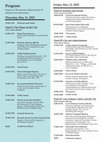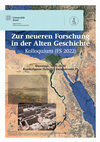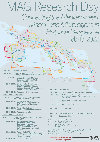Talks by Lucas Weisser-Gericke

In the last couple of years, we have been working towards the creation of “urban prosopographies”... more In the last couple of years, we have been working towards the creation of “urban prosopographies” of the two important Middle Egyptian cities that stand at the center of our research project, “Urban Biographies of the Roman and Late Antique Worlds: Antinoopolis and Heracleopolis in Egypt, c. 100 – c. 650 CE”, funded by the Swiss National Science Foundation and based at the Department of Ancient History of the University of Basel (PI: Sabine Huebner). With this talk we aim to explain the creation of our database, its functioning, and its potential uses. In this we have been collaborating with the KU Leuven-based Trismegistos project, using the prosopographical ‘raw data’ collected in Trismegistos People as a starting point. After the review of the prosopographical data contained in (mostly, but not exclusively papyrological) texts from Antinoopolis or Heracleopolis or mentioning one of these sites, these data sets have been imported into the virtual research environment Geovistory, specifically developed by the company KleioLab to host and analyze data collected during and for historical research and to visualize the results of such analyses. A brief case study performed on our ‘urban prosopographies’ will illustrate the contribution of these datasets to historical research on Roman and Early Byzantine Antinoopolis and Heracleopolis and urbanism in (Late) Roman Egypt and the (Late) Roman Empire in general.

After they had been granted city councils by Septimius Severus in the early third century and thu... more After they had been granted city councils by Septimius Severus in the early third century and thus acquired civic status, Egyptian nome capitals began to adorn their names with various honorific epithets, such as λάμπρα, and combinations thereof. Previous inquiries into this (nearly exclusively papyrological) phenomenon have mostly been concerned with compiling the pertinent material (Zehetmair 1912; Hornickel 1930; Hagedorn 1973; Litinas 1995) or pointing out its potential contribution to the dating of otherwise undated papyri (Hagedorn 1973); a historical interpretation has yet to be carried out. Focusing on the titles of Middle Egyptian Heracleopolis Magna, this contribution suggests to conceptualize the use of individualizing (combinations of) honorific epithets as dialogical in character and as a means of the interurban competition for prestige so vital in third-century Egypt – the ‘inflationary’ use of superlatives such as λαμπροτάτη bears witness to both. The papyrological (and epigraphical) material on Heracleopolitan epithets (ἀρχαία καὶ θεοφιλής, ἀθάνατος, μεγάλη, and, supposedly, λαμπροτάτη), ranging from the third to the fifth centuries, will be reviewed and analysed, through a comparison with the epithets of other Egyptian cities, as to the communicative strategies employed to single out Heracleopolis among its urban competitors.
This contribution is concerned with modes of expressing local urban identity in the Middle Egypti... more This contribution is concerned with modes of expressing local urban identity in the Middle Egyptian city of Heracleopolis magna in the Roman period (1st–4th c. C.E.) The central role of the worship of local deities for the formation of local identity has been pointed out by Fredrik Hagen for Pharaonic Egypt (Hagen 2007). The ongoing importance of this factor for the expression of local identity in Roman Egypt will be demonstrated by a detailed analysis of the peculiarities of the local onomastic pool of Heracleopolis as reflected in the papyrological material.

The ancient city of Herakleopolis Magna, the modern Inhasya Al-Medina, was continuously occupied ... more The ancient city of Herakleopolis Magna, the modern Inhasya Al-Medina, was continuously occupied since the beginning of the Pharaonic period until the Byzantine era. The strategic geographical position on the Bahr Yussuf and its direct connection with the Fayyum influenced the economic role and trade network of the city the urbanism and material culture consequently.
The first expedition in search of papyri was carried out in 1889 by a German mission led by Ulrich Wilcken. He published a useful report of his work on the site and the first archaeological map where were placed all the buildings visible on the surface. Between 1890 e the first years of XVIII century Egypt Exploration Fund financed 3 new seasons of archaeological investigations in the site directed by Naville and Petrie. Despite stone-robbing and sebbakhin activities in this period there were still big mounds belonging to the Roman, Byzantine and Islamic Periods. To better understanding the archaeological record, today largely disappeared, and to reconnect and recontextualize the papyri found by Wilken it was necessary to analyse the archives of the historical excavations carried out in this settlement. Letters, diaries and all the notes written in this period are very important to reconstruct both the urban layout of the settlement in the Roman and Late Antique period and his long-term development.
This contextual approach is part of the project Urban Biographies of the Roman and Late Antique Worlds: Antinoopolis and Heracleopolis in Egypt, c. 100 – c. 650 CE financed by Swiss National Science Foundation (SNSF) and started at the University of Basel on August 1st 2021.

Forget Bethlehem – a Medieval Arabic tradition holds that Maria gave birth to her son Jesus in th... more Forget Bethlehem – a Medieval Arabic tradition holds that Maria gave birth to her son Jesus in the Middle Egyptian city of Ehnas, Roman Heracleopolis magna. Heracleopolis was a stronghold of Coptic culture under Byzantine and Arabic rule; The origins of its Christian community, as of Egyptian Christianity in general, are rather obscure, though. Bringing forward all the available evidence – above all literary (Coptic acts of the martyrs, Historia Episcopatus Alexandriae, Sozomenus) and papyrological (Christian names, letters, and literary manuscripts) – this lecture will spotlight the early years of Christianity in Heracleopolis (c. 200-350 C.E.). Special attention will be paid to P. Oxy. XXXVI 2785, a formulaic letter of recommendation from the presbyters of Heracleopolis, on the date of which the recently edited Historia Episcopatus Alexandriae – which also provides the names of some pre-Byzantine Heracleopolitan bishops – sheds new light, and to the crucial role of Heracleopolis in the Melitian schism. The evidence from the Heracleopolite nome – which includes some of the earliest extant Christian literary manuscripts – will be taken into account as well.

Trotz der durchaus reichhaltigen papyrologischen Dokumentation rechnet der Herakleopolites, zumal... more Trotz der durchaus reichhaltigen papyrologischen Dokumentation rechnet der Herakleopolites, zumal in seinem römischen Zeitabschnitt, zu den weniger erforschten Gauen des nachpharaonischen Ägyptens. Aus der Perspektive eines dem römischen Herakleopolis magna gewidmeten Promotionsvorhabens widmet sich dieser Vortrag den wechselseitigen Beziehungen zwischen metropolis und nomos im 20. oberägyptischen Gau vom 2.-4. Jhd. n. Chr. (mit Schwerpunkt auf die vordiokletianische Zeit). Nach einer diachronen Darstellung der rechtlichen und administrativen Rahmenbedingungen sollen die herakleopolitischen Papyri des Untersuchungszeitraums – die weit überwiegend metropolitanischer Provenienz sind – auf die konkreten Formen, die dieses Verhältnis annehmen konnte, befragt werden. Prominent tritt dabei etwa die Rolle der metropolis als Gauverwaltungszentrum, aber auch als von Gaubewohnern durch Darlehen anzapfbares Reservoir finanzieller Ressourcen hervor, während der nomos primär als Objekt des Landbesitzes von Metropoliten in das Blickfeld der Quellen tritt. Damit drängt sich auch die Frage nach der Repräsentativität der sich in den Papyri spiegelnden Interaktionen zwischen Metropoliten und Gaubewohnern auf.
Papers by Lucas Weisser-Gericke










Uploads
Talks by Lucas Weisser-Gericke
The first expedition in search of papyri was carried out in 1889 by a German mission led by Ulrich Wilcken. He published a useful report of his work on the site and the first archaeological map where were placed all the buildings visible on the surface. Between 1890 e the first years of XVIII century Egypt Exploration Fund financed 3 new seasons of archaeological investigations in the site directed by Naville and Petrie. Despite stone-robbing and sebbakhin activities in this period there were still big mounds belonging to the Roman, Byzantine and Islamic Periods. To better understanding the archaeological record, today largely disappeared, and to reconnect and recontextualize the papyri found by Wilken it was necessary to analyse the archives of the historical excavations carried out in this settlement. Letters, diaries and all the notes written in this period are very important to reconstruct both the urban layout of the settlement in the Roman and Late Antique period and his long-term development.
This contextual approach is part of the project Urban Biographies of the Roman and Late Antique Worlds: Antinoopolis and Heracleopolis in Egypt, c. 100 – c. 650 CE financed by Swiss National Science Foundation (SNSF) and started at the University of Basel on August 1st 2021.
Papers by Lucas Weisser-Gericke
The first expedition in search of papyri was carried out in 1889 by a German mission led by Ulrich Wilcken. He published a useful report of his work on the site and the first archaeological map where were placed all the buildings visible on the surface. Between 1890 e the first years of XVIII century Egypt Exploration Fund financed 3 new seasons of archaeological investigations in the site directed by Naville and Petrie. Despite stone-robbing and sebbakhin activities in this period there were still big mounds belonging to the Roman, Byzantine and Islamic Periods. To better understanding the archaeological record, today largely disappeared, and to reconnect and recontextualize the papyri found by Wilken it was necessary to analyse the archives of the historical excavations carried out in this settlement. Letters, diaries and all the notes written in this period are very important to reconstruct both the urban layout of the settlement in the Roman and Late Antique period and his long-term development.
This contextual approach is part of the project Urban Biographies of the Roman and Late Antique Worlds: Antinoopolis and Heracleopolis in Egypt, c. 100 – c. 650 CE financed by Swiss National Science Foundation (SNSF) and started at the University of Basel on August 1st 2021.